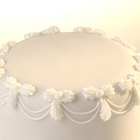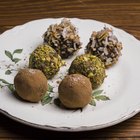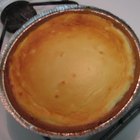
Buttercream frosting, the most common frosting used to decorate cakes, is typically made from powdered sugar, butter, milk and vanilla, but buttercream frosting made with powdered sugar isn't the only option for frosting cakes. You can make a version of buttercream frosting with granulated sugar if that's all you have on hand. If you don't like buttercream frosting, try an alternative type of frosting for your cakes and cupcakes.
Granulated Sugar Frosting
Powdered sugar dissolves easily in cool milk and butter in a standard buttercream recipe, but extra effort is needed when using granulated sugar so the frosting isn't gritty. This style of buttercream uses equal parts granulated sugar, milk and butter, as well as about 5 tablespoons of flour for every cup of milk, and vanilla. Cook the milk and flour over medium heat, stirring constantly, until roughly the consistency of pancake batter; allow it to cool completely and stir in vanilla to taste. To remove grittiness, the butter and sugar are whipped in a mixer until smooth and creamy before adding the thickened milk mixture. This mixture requires several minutes whipped at high speed to make it as light and fluffy as regular buttercream.
Fondant
Cakes are often covered in fondant when a perfectly smooth finish is desired. This dough-like frosting alternative can be rolled out thin to cover the cake, and is often molded to make decorations to embellish the fondant covering. Before you can lay the thin fondant sheet over the cake, you must apply a thin layer of buttercream frosting, which acts as a glue to hold the fondant on the cake. Fondant is sold in bulk tubs of white fondant that you can color with gel food coloring, but you can often find it pre-tinted in primary and pastel colors.
Chocolate Ganache
Chocolate ganache makes a more decadent alternative to chocolate buttercream frosting made from powdered sugar. Heavy whipping cream is heated to a simmer, poured over chopped chocolate, and stirred until the chocolate is completely melted and thoroughly combined with the cream. Pour the warm ganache over a cake immediately after mixing to make a thin, shiny glaze on top of the cake. If you want to spread it with an icing spatula, allow it to cool at room temperature for about half an hour. To make whipped ganache that you can apply with a decorating bag and decorating tip, refrigerate until completely cool and slightly hardened. Whip the cooled ganache with an electric mixture for several minutes until it's light and fluffy.
Stabilized Whipped Cream
Whipped cream makes a creamy and light alternative to traditional buttercream frosting. Whipped cream is an emulsion that can break or melt soon after applying it to a cake, so you must first stabilize it so it holds its shape. There are several methods for achieving stabilized whipped cream, but the easiest is to mix piping gel into it, using roughly 1 tablespoon of piping gel per cup of whipped cream. Another option is to cook gelatin with a bit of water, allow the gelatin to cool, and stir it into the whipped cream. Whipped cream is often sweetened with powdered sugar, but you won't miss the sugar if you pair the topping with a sweet, rich dessert.
Related Articles
How to Make White Drizzle Frosting

Can I Thicken Ganache With Powdered ...

How to Make a White Decorator Icing

Can You Use Heavy Cream When Making ...

How to Make Cake Frosting Into a ...
Simple Chocolate Frosting Recipe

How to Fix Grainy Whipped Ganache

How to Make Drizzle Icing From Frosting ...
How to Make Drizzle Icing From Frosting ...

How to Make Almond Buttercream Frosting

How to Make Your Own Chocolate Truffles

How to Use Gelatin to Thicken Frosting

How to Make Creme Brulee Without a Torch

How to Make Whipped Frosting for Cake ...

Ganache Substitute

How to Bake Sugar Free Cheese Cake

What Happens if You Whip Condensed Milk?

Do You Need to Refrigerate Whipped ...

How to Heat Canned Icing

How to Make Frosting Using All-Purpose ...
References
Writer Bio
A former cake decorator and competitive horticulturist, Amelia Allonsy is most at home in the kitchen or with her hands in the dirt. She received her Bachelor's degree from West Virginia University. Her work has been published in the San Francisco Chronicle and on other websites.
Photo Credits
Jupiterimages/Stockbyte/Getty Images